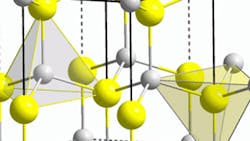GaN Enters 5G Territory
Fifth-generation (5G) networks promise to offer significantly better performance than today’s wireless networks. Specifically, these performance improvements include faster data rates, greater area traffic capacity, and lower latency. Greater network efficiency is another advantage expected with 5G. In the white paper, “Gallium Nitride—A Critical Technology for 5G,” Qorvo discusses the role that gallium-nitride (GaN) technology is likely to play in future 5G networks.
According to the white paper, 5G promises to deliver latency below 1 ms, 20-Gb/s peak data rates, and area traffic capacity of 10 Mb/s/m2. In addition, 5G is expected to offer improved efficiency, allowing for a more “green” communications network. Furthermore, objectives of 5G include delivering increased power levels and utilizing frequencies as high as 100 GHz.
To meet green network goals, 5G networks are likely to utilize GaN technology. GaN possesses a number of characteristics that allow for an improved overall efficiency in the RF chain. Its entrance into the base-transceiver-station (BTS) market space is detailed, as GaN technology has yielded greater efficiency in this arena. Moreover, the white paper notes that manufacturers must offer several GaN variations that span a wide array of frequencies and power levels to meet a diverse range of 5G requirements.
In addition, according to the paper, GaN will overtake traditional semiconductor technologies in applications like higher-frequency, size-constrained small cells. Another prediction is that low-voltage GaN will ultimately find its way into mobile handsets. GaN can also operate in high-temperature environments, making it well-suited for passively cooled, all-outdoor base-station electronics, as well as automobile applications.
Lastly, millimeter-wave frequencies are discussed, as they are heavily tied to 5G. The white paper explains that GaN is an excellent fit for higher-frequency, wide-bandwidth applications. And with millimeter-wave applications utilizing beamforming technology, RF subsystems will therefore require a large number of active elements driving a relatively compact aperture. GaN technology is primed for such applications, as it can satisfy performance and small package-size requirements.
Qorvo Inc., 7628 Thorndike Rd., Greensboro, NC 27409; (336) 664-1233

